Initial excitement soon turns to disappointment when MIKE WARD diver-tests the DJI Osmo Action 4 in an overcast Yorkshire lake
Chinese manufacturer DJI claims that its Osmo Action 4 action-cam delivers better results in low light. Better than what, you might ask?
The preceding Action 3, its says, though we assume that what it really means is better than the mighty GoPro.
So let’s find out if the Action 4 is any good. Because DJI makes so much of the low-light abilities of the Action 4, I took it up to Ellerton Park Lake on an overcast November afternoon and went diving not too long before sunset. Perfect conditions to see what the Acton 4 is made of, in other words.
Think of it like this: if a nice sunny day is a stroll in the park, that afternoon at Ellerton was mountain-climbing in a blizzard. Even half-decent results would be a miracle, I thought, as I pulled on my gloves.
The camera
The DJI Osmo Action 4 looks like pretty much every other range-topping action camera on the market. It’s an oblong box with a super-wide-angle lens, a small selfie screen on the front and a larger screen for view-finding taking up most of the rear.
Both screens provide some shooting information as well as view-finding and are touch-sensitive. DJI expects you to use the rear screen for set-up, though there’s an app if you prefer, and the menus and options are clear and logically laid out.
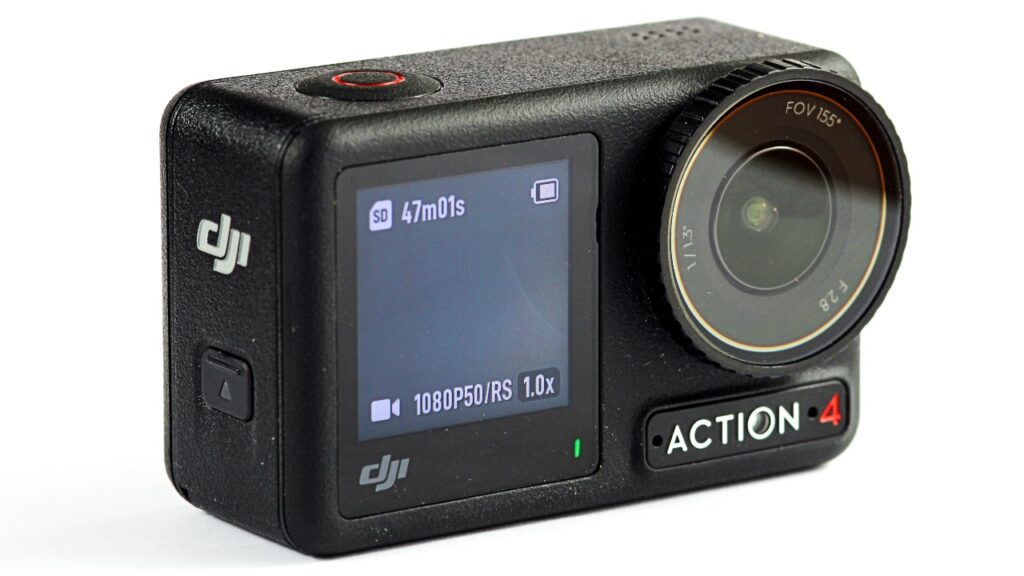
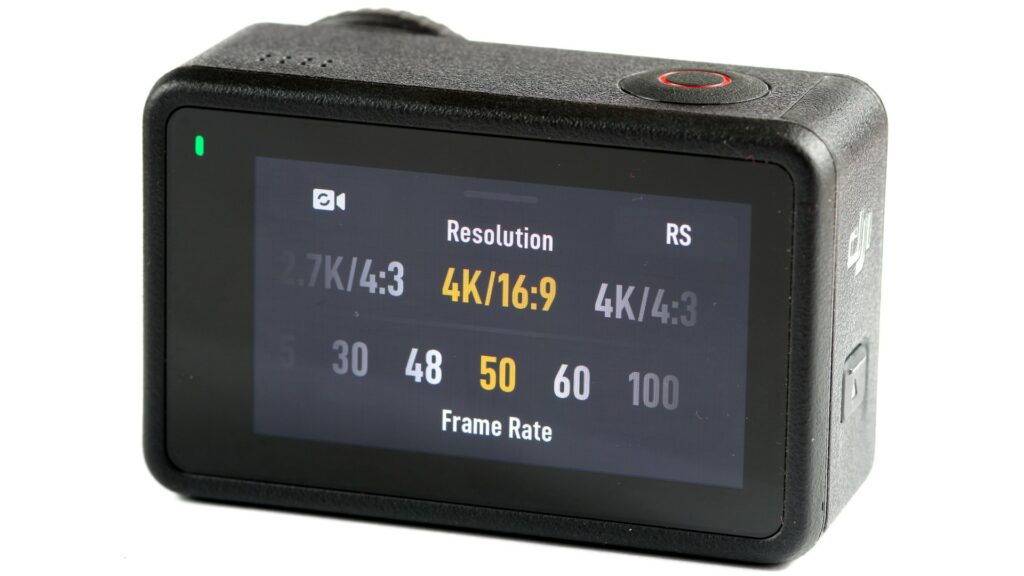
You won’t need the manual, which is good because it isn’t the clearest document in the world and, once set, the camera will remember your preferences.
The shutter button is on the top plate at the right, with the power button on the left side toward the top, as viewed from the rear of the camera. This also sets the camera to video, stills or time-lapse shooting.
The battery and micro-SD memory-card are found under a sliding door on the right and there’s a smaller door on the lower left, behind which is a USB-C slot for charging and downloading footage. Both doors have a small but effective lip for purchase when opening.
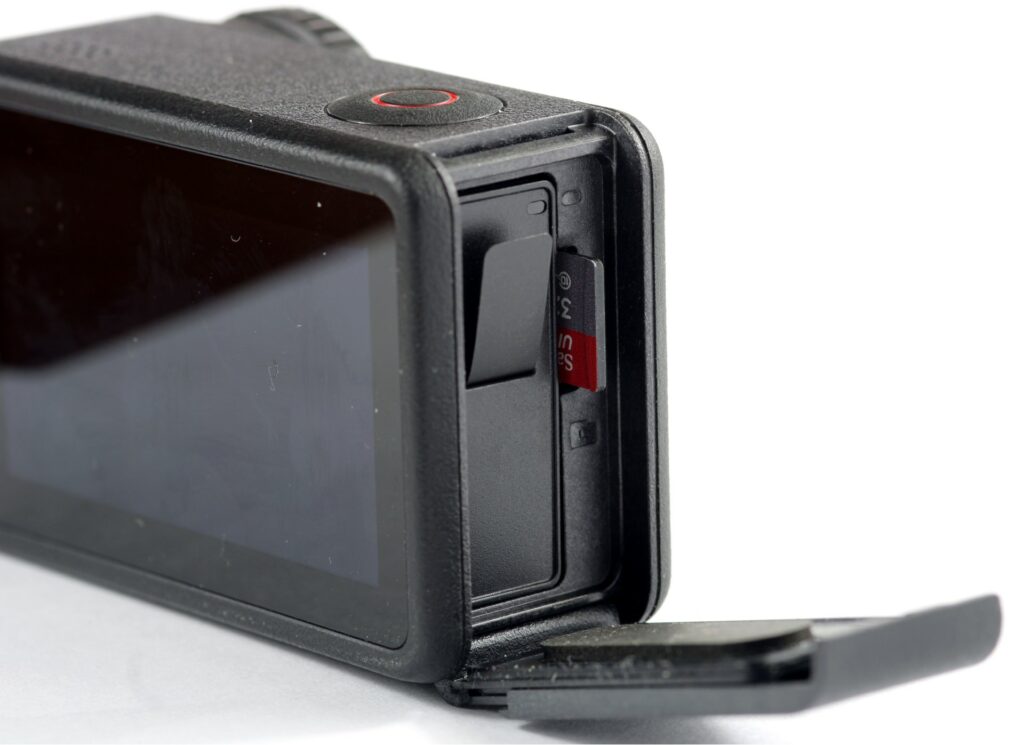
DJI says that the Action 4 will go down to a depth of 18m without a housing, but there’s a matching 60m housing if, like me, you feel reassured by some extra waterproofing.
The camera drops into the housing easily and is held securely without any rattles, and the housing buttons were nicely judged for feel and travel, even wearing thick gloves. Overall, the combination feels solid and well-built, like it’ll survive the sort of abuse diving tends to dish out.

So far, so generic, but the Action 4 has two potentially very important features for scuba divers, especially in UK waters.
First, DJI has chosen to use a larger sensor with fewer pixels in its quest for better low-light performance. This is brave.
Yes, the Action 4 sensor has more than twice the area of the GoPro sensor (as a rough comparison, if the Action 4 sensor is the size of your thumbnail, the GoPro sensor is the nail on your little finger).
However, the Action 4 offers “only” 4k video and 10 million-pixel photos, while the GoPro 12 offers 5.7k video and 27 million-pixel stills, and that sounds much more definite and impressive than airy-fairy claims about better image quality.
Ah, yes, you say, but that also means that Action 4 pixels must be waaay bigger than GoPro pixels, which is a Good Thing for image quality, and you’d be right.
GoPro doesn’t say how big its pixels are, but three times as many pixels in half the area suggests they’d be around a fifth or a sixth the size of the Action 4 pixels.
Second, DJI has put a dedicated colour-temperature sensor on the front plate of the camera. It’s behind the ‘O’ in the Action 4 name, and that should be of real benefit to divers who want to shoot colourful footage.
In action
Time to shoot some video, and apparently miracles do happen! Somehow the Action 4 set to Wide lens and Normal colour was recording sharp and colourful footage of the rocks on the bottom of Ellerton Lake and, when I swam over an area of fallen leaves, the autumn colours stood out very nicely.
The footage was usable straight from the camera, with only the most minor post-processing needed to make the colours pop. Good start, and it also showed the -0.7 exposure compensation that I’d set wasn’t necessary. DJI had judged its standard exposure level very accurately.
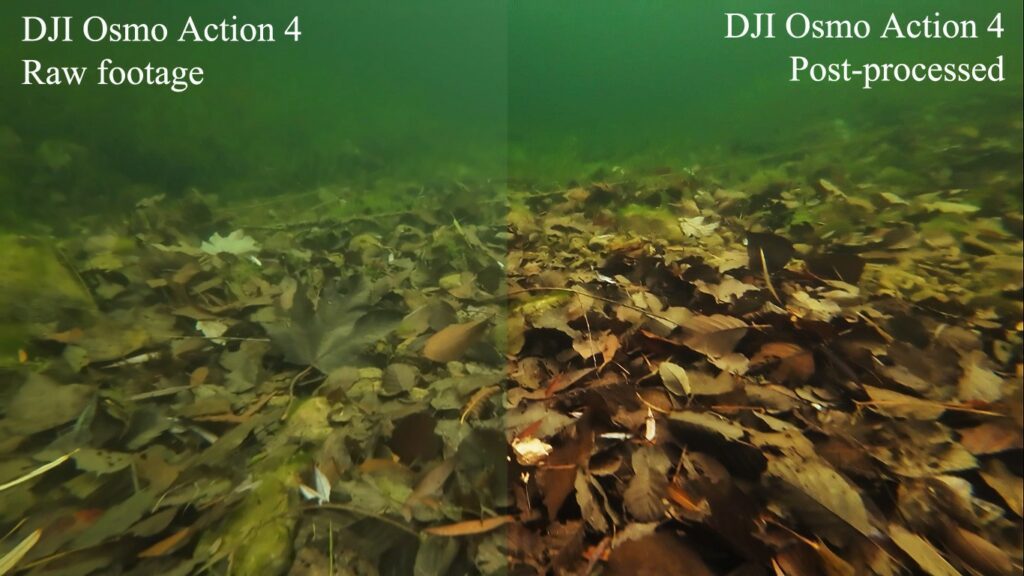
Next up, a swimming diver. Shot using the Wide lens and Normal colour balance, that footage too was usable direct from the camera.
Actually, it was very nice, with good colour balance and detail, and again only the most minor tweaking was needed to take it up a level, but at the end of the shot the colour balance changed to something very green and not nice. Odd, I thought, must be a one-off glitch.
Then I tried my rollover test. I point the camera at the bottom and barrel-roll so that it tracks to the surface, then back to the bottom. The idea is to see how quickly, smoothly and accurately the exposure and colour balance track the change.
The DJI reacted very well on the way up and delivered a nice exposure of the surface. That’s the larger sensor and pixels of the Action 4 delivering greater dynamic range as promised – but then the Action 4 adjusted exposure but not white balance as I rolled back to the lake-bed. It needed a second rollover to get back to an accurate colour balance on the lake-bed. Hmm.
Not too far away is what’s left of a car, and the Action 4 started that shot with a very green overall colour balance. I was just about to turn the camera off and start again when the colour balance changed to something much better.
At least it then stayed constant for the rest of that shot, but in subsequent shots the colour balance just wasn’t reliable. Half the time it would be great all the way through, but sometimes it would start good and then change for the worse, or start badly and change to good, or just stay bad all through. Grrr!
Other options
During a short surface interval, I altered the colour mode of the Action 4 to the D-Log M setting, which produces a flatter file with a wider tonal range, intended to be post-processed. I was hoping that it might also resolve the colour-balance issue, but it didn’t.
What it did do was to allow a more subtle, cinematic result that was lovely, even from such poor conditions, though you need to be aware that low-powered computers will struggle with them, and if you don’t post-process they’ll just look flat and dull.
Back in the lake is a boat-wreck, covered with weed, and the DJI did a lovely job of resolving detail and rendering the colours of the weed and the peeling paint on the boat. When those D-Log M files are good, they’re bangin’!
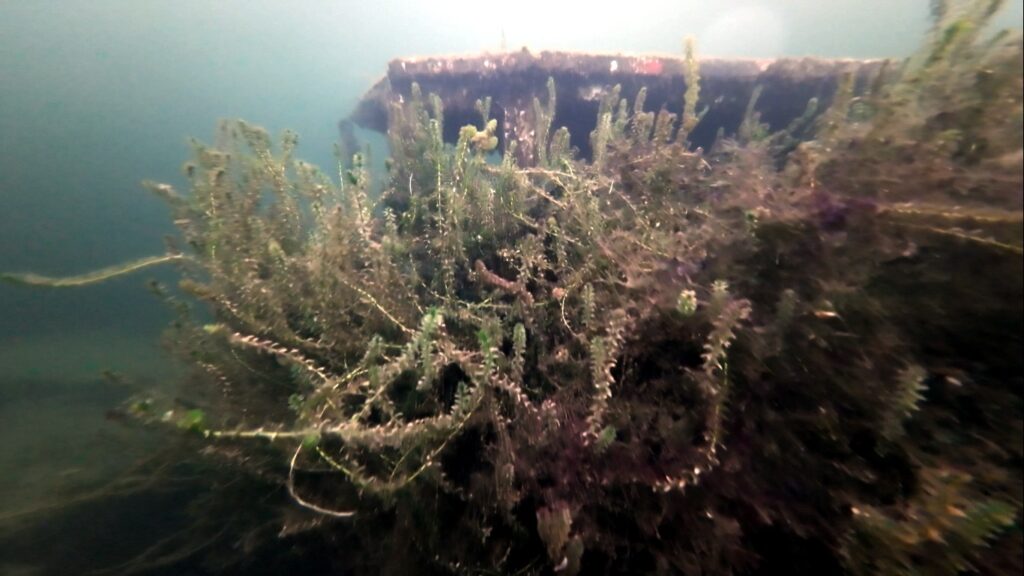
Oh, and I’d also switched the lens to the super-wide view, which produced that tunnel-vision look familiar from ultra-wide lenses on other action cameras. It was no worse, no better than other cameras but, having tried it, I’d stick to the wide setting.
Back to the boat, where there’s a large bow compartment accessible only through a small doorway, which I proceeded to block as I poked the camera through.
In pretty much total darkness the DJI happily recorded the details of the internal wooden construction. It wasn’t the greatest footage the world has ever seen – in truth it was pretty shabby – but there’s detail on the video, and to prove the low-light chops weren’t a fluke it repeated the performance on a swim-through some dark concrete pipes.
I’ll fess up and say that I’d taken my GoPro as well, and the DJI Action 4 was clearly, obviously and unequivocally better.
Maker’s comments
At which point, I might as well cut a long story short. Remember that these dives were made in poor conditions to deliberately push the Action 4, and in the most extreme places the DJI Osmo Action 4 was clearly and unarguably better than my GoPro. Everywhere else, it could be just as good.
That finding should make it a no-brainer, just buy the Action 4! Except that unreliable colour balance makes it unusable, at least in my book. Surprised and very disappointed, I haven’t seen colour balance so uneven since I got rid of a Muvi K2 in 2015.
I sent two of the original video files to DJI for comment. Its initial response, and I quote its first email response in its entirety: “It takes time for underwater detection in low light underwater.” This didn’t seem all that helpful, so I pushed back and got the following:
About one video file: “An underwater environment that is too dark is not recognised as ‘water’ by the colour optimisation. The camera algorithm cannot determine that it is currently underwater, and so the colour mode switches between the two as it tries to use the right setting for the scenario.”
And for the second clip DJI commented: “For video the water is not very clear and the light ratio is very dark. The camera’s underwater algorithm starts to recognise that it is underwater at about 13 seconds and the underwater colour is applied from then on.”
Essentially, then, DJI confirms that the DJI Osmo Action 4 doesn’t work very well in low light, especially under water. Not much point in you or I buying one, then. My score: 6/10
The DJI Osmo Action 4 camera is priced at £379, or £438 for the Diving Combo with housing, but see the DJI website for buying options for specific activities and extra batteries.

MIKE WARD has been diving for almost 40 years and writing about his experiences for most of that time. He dives regularly at home and works with Scuba Travel to escort specialist wreck-diving safaris overseas.
Also by Mike Ward on Divernet: Let’s get physical: life-cycle of a diver, Divers’ complete guide to drysuit selection, Scapa Flow 100 history & wrecks



I bought my first action camera after more than 1, an Osmo Action 4 four days ago after it hit a lowest price. It was $388 for the Adventure Bundle with 1.5 m selfie stick and two additional batteries with a three battery fast charger, most importantly. After 8.25% tax it was $420.
I find it fantastic for vlog type and mountain biking videos which is what I do, especially when paired with an neutral density filter or polarized filter. Having said that, what’s your camera of choice for underwater adventures, then?
From my experience with quite a few cameras, They all have strengths and weaknesses. I’ve not had a issue with my Osma 4. But then I take short 10 seconds clips, The white balance wasn’t a issue for me in the way I use it. To be fair many cameras have some idiosyncrasies changing white balance to some degree, its often overcome by presetting the colour temperature, this can be done in presets on the action 4.